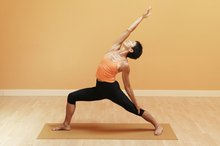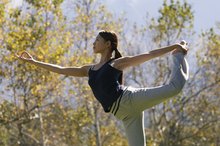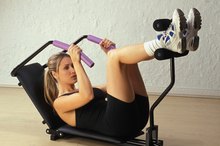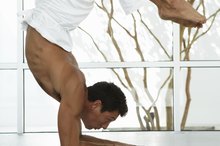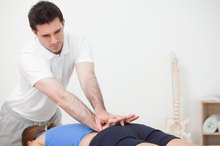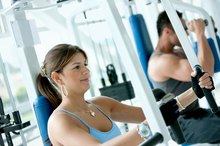Uterus-Strengthening Yoga Postures
If you have heavy, painful periods or your uterus has dropped into your vaginal canal as a result of weakened ligaments and pelvic muscles -- a condition known as a prolapsed uterus -- yoga poses may be able to help 1. According to Swami Satyananda Saraswati, in an article for "Yoga" magazine, asanas can also help correct a retroverted, or tipped, uterus 2.
If you are experiencing serious medical symptoms, seek emergency treatment immediately.
Boat Pose
Boat pose, also called navasana or naukasana, helps with balance during pregnancy. According to MyYogaOnline.com, it also strengthens your abs, hips and thighs. In this pose, you balance on your butt and lift your upper body and legs into the air so your body looks like the letter "V." As you reach past your knees with your extended arms, your lower abs work to help you keep your balance. Over time, YogaWiz.com reports, boat pose can help a prolapsed uterus fall back into place 1.
- Boat pose, also called navasana or naukasana, helps with balance during pregnancy.
- In this pose, you balance on your butt and lift your upper body and legs into the air so your body looks like the letter "V." As you reach past your knees with your extended arms, your lower abs work to help you keep your balance.
Upward Abdominal Lock
Yoga Spine Alignment
Learn More
Upward abdominal lock, or Uddiyana Bandha, incorporates a specific breathing technique that combines with a standing posture to engage your lower abdominal organs 4. To do this pose, bend at the waist, bend your knees slightly and rest your hands on your knees. Inhale through your nose, exhale strongly through your nose and pull your abdominal muscles in tight to push the rest of the air out of your lungs. Expand your rib cage without inhaling, which pulls in the lower abs. Hold for 10 to 15 minutes before you exhale and return to breathing normally. Repeat three times.
- Upward abdominal lock, or Uddiyana Bandha, incorporates a specific breathing technique that combines with a standing posture to engage your lower abdominal organs 4.
- Inhale through your nose, exhale strongly through your nose and pull your abdominal muscles in tight to push the rest of the air out of your lungs.
Shoulderstand
Sarvangasana, or shoulderstand, usually takes place at the end of a yoga class. In this pose, you rest your upper body on a folded blanket with your head hanging off or directly on the mat if it doesn't hurt your neck. By reaching behind your back with your elbows bent and the palms of your hands resting on your mid-back, you can lift your legs straight up in the air. Tucking in your lower abdominal muscles, pointing your toes and keeping your back straight help maintain the posture. According to Swami Satyananda Saraswati, this common inversion, usually held for at least three minutes in class, helps relieve the pain of a prolapsed uterus and return it gently to its correct position in the body 1.
- Sarvangasana, or shoulderstand, usually takes place at the end of a yoga class.
- In this pose, you rest your upper body on a folded blanket with your head hanging off or directly on the mat if it doesn't hurt your neck.
Yoga During Menstruation
How to Correct Pulled Forward Shoulders
Learn More
Backbends and standing balancing poses may also be difficult when you have your period. Instead, focus on restorative poses, such as forward bends, seated twists and supported bridge. Replace wheel, or backbend, with supported bridge by placing an upright block beneath your sacrum. Yin Yoga classes, which focus on restorative poses for the lower body, can also be particularly comforting during menstruation.
- Backbends and standing balancing poses may also be difficult when you have your period.
- Yin Yoga classes, which focus on restorative poses for the lower body, can also be particularly comforting during menstruation.
Related Articles
References
Writer Bio
Henry is a Philadelphia-based personal trainer and writer. He has trained a wide range of clients, from professional athletes to working professionals. Feel free to contact Henry with any questions regarding an article that he's written.
